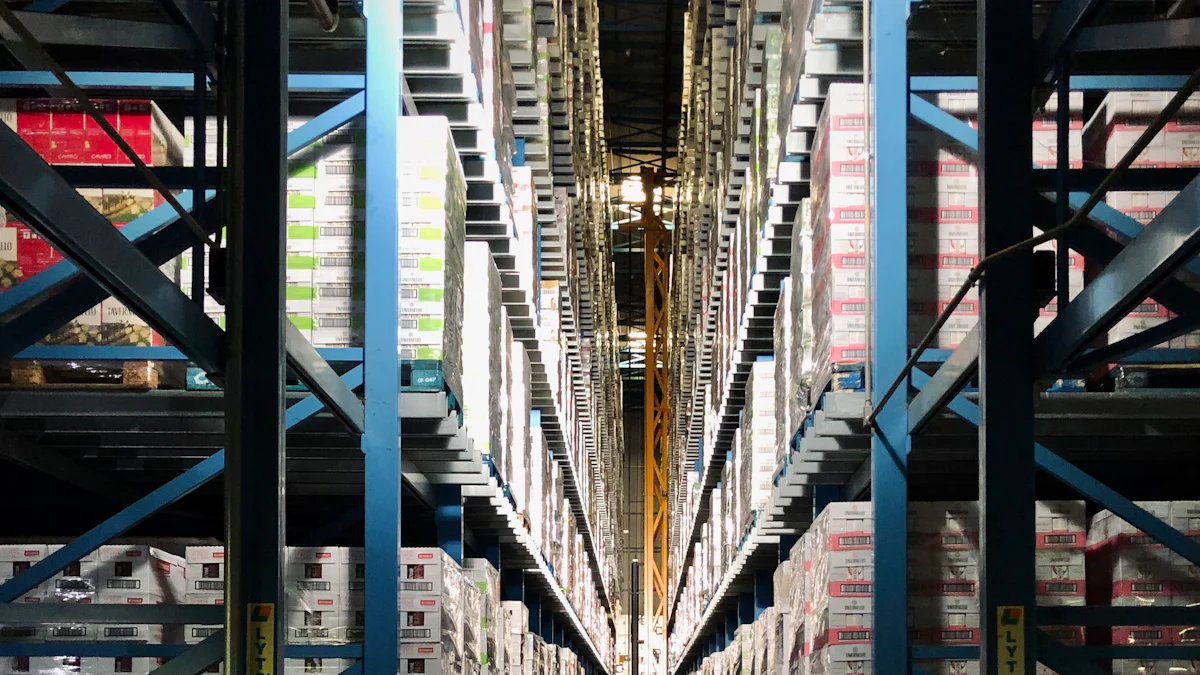Green Logistics: Implementing Sustainable Solutions

Green logistics involves implementing sustainable practices to reduce the environmental impact of transportation and supply chain activities. Companies are increasingly embracing green logistics to improve their environmental performance, reduce costs, and enhance competitiveness. By minimizing energy consumption and emissions, green logistics not only leads to cost savings but also contributes to a cleaner future. This blog will delve into the definition of green logistics, highlight its importance in sustainability, and provide a structured overview of strategies for adopting eco-friendly practices.
Understanding Green Logistics
Definition and Scope
Green logistics encompasses a set of practices aimed at reducing the environmental impact of transportation and supply chain activities. Embracing green logistics involves implementing strategies that prioritize sustainability, leading to improved environmental performance and reduced costs for companies.
Key Components of Green Logistics
Implementing energy-efficient transportation methods
Utilizing eco-friendly packaging solutions
Optimizing supply chain processes for reduced emissions
Historical Context and Evolution
In the early 1990s, the concept of green logistics began to take shape as businesses started focusing on minimizing their environmental footprint in logistical operations. With the rise in greenhouse gas emissions, there has been an increasing interest in adopting sustainable practices within the logistics sector.
Environmental Impact of Traditional Logistics
Traditional logistics operations often contribute significantly to carbon emissions and resource consumption. By transitioning to green logistics, companies can mitigate these impacts through innovative solutions.
Carbon Footprint
Leading retail giants have reported up to a 20% reduction in carbon emissions by optimizing delivery routes and fleet management.
Sustainable transportation practices play a crucial role in reducing carbon footprints across supply chains.
Resource Consumption
Green logistics practices aim to minimize resource consumption by promoting reuse, recycle, refurbish, and remanufacture techniques.
Adopting sustainable technologies can help reduce wastage and promote efficient resource utilization.
Regulatory and Market Drivers
Various factors are driving the adoption of green logistics, including government regulations and increasing consumer demand for sustainability. Companies that align with these drivers gain strategic advantages while contributing to a cleaner future.
Government Regulations
Compliance with environmental regulations is becoming increasingly important for businesses operating in the logistics industry.
Governments worldwide are introducing policies that incentivize eco-friendly practices within supply chains.
Consumer Demand for Sustainability
Consumers are showing a growing preference for environmentally responsible products and services.
Meeting consumer expectations for sustainable practices can enhance brand value and competitiveness in the market.
Strategies for Implementing Sustainable Solutions

Transportation Optimization
Route Planning and Optimization
Effective route planning and optimization are essential components of green logistics. By strategically mapping out delivery routes, companies can minimize fuel consumption and reduce carbon emissions. Utilizing advanced route optimization software helps in identifying the most efficient paths, leading to cost savings and environmental benefits.
Use of Eco-friendly Vehicles
The integration of eco-friendly vehicles is a key strategy in sustainable transportation practices. Electric trucks and hydrogen-powered vehicles are gaining popularity in the logistics sector due to their lower carbon footprint. Companies can significantly reduce emissions by transitioning to these environmentally friendly transport options, contributing to a cleaner environment.
Warehouse and Inventory Management
Energy-efficient Warehousing
Implementing energy-efficient practices in warehousing operations is crucial for promoting sustainability. By optimizing lighting systems, HVAC units, and insulation, companies can reduce energy consumption and lower their environmental impact. Investing in renewable energy sources such as solar panels further enhances the efficiency of warehouse facilities.
Sustainable Packaging Solutions
Sustainable packaging solutions play a vital role in reducing waste generation within supply chains. Companies can opt for biodegradable materials or reusable packaging options to minimize environmental harm. Embracing innovative packaging designs that promote recyclability and reusability contributes to a more sustainable approach in logistics operations.
Technology and Innovation
Role of IoT and Big Data
The integration of IoT (Internet of Things) and big data analytics revolutionizes the way logistics processes are managed. By leveraging real-time data insights from connected devices, companies can optimize resource utilization, enhance operational efficiency, and reduce environmental impact. IoT technology enables proactive decision-making based on accurate information, leading to greener logistics practices.
Automation and Robotics
Automation and robotics technologies streamline warehouse operations while promoting sustainability. Automated systems improve inventory accuracy, reduce errors, and optimize space utilization within warehouses. By minimizing human intervention through robotic solutions, companies can enhance productivity levels while adhering to eco-friendly practices.
Benefits of Green Logistics
Environmental Benefits
Reduction in Emissions
Green logistics focuses on reducing carbon emissions to minimize the ecological impact of transportation and supply chain activities.
Implementing energy-efficient transportation methods and optimizing delivery routes can lead to a significant reduction in emissions.
By utilizing eco-friendly vehicles like electric trucks, companies can contribute to a cleaner environment by lowering their carbon footprint.
Conservation of Resources
Green logistics promotes resource conservation through sustainable practices such as reuse, recycle, refurbish, and remanufacture techniques.
Companies embracing green principles prioritize efficient resource utilization to minimize waste generation.
Investing in renewable energy sources for warehouse operations further enhances resource conservation efforts.
Economic Benefits
Cost Savings
Embracing green logistics can result in substantial cost savings for companies through efficient logistics practices and optimal resource utilization.
Lower operational costs are achievable by implementing sustainable technologies that promote energy efficiency and waste reduction.
Companies focusing on green initiatives benefit from reduced expenses associated with fuel consumption and packaging materials.
Enhanced Brand Image
Adopting green logistics practices enhances a company's brand image by showcasing a commitment to environmental sustainability.
Consumers increasingly value businesses that prioritize eco-friendly solutions, leading to improved brand reputation and customer loyalty.
A strong emphasis on sustainability not only attracts environmentally conscious consumers but also differentiates companies in competitive markets.
Social Benefits
Improved Public Health
The adoption of green logistics contributes to improved public health by reducing air pollution and harmful emissions.
Sustainable transportation practices lead to cleaner air quality, benefiting communities located near transport routes and warehouses.
Prioritizing social well-being through green initiatives demonstrates corporate responsibility towards public health concerns.
Community Engagement
Engaging with local communities is an essential aspect of green logistics, fostering positive relationships and mutual support.
Companies implementing sustainable solutions often involve communities in environmental initiatives, promoting awareness and collaboration.
By actively participating in community engagement programs, businesses create a sense of shared responsibility for environmental stewardship.
Challenges in Implementing Green Logistics
Financial Constraints
Implementing green logistics practices often presents organizations with initial investment costs that can be a barrier to adoption. Companies need to allocate resources for transitioning to sustainable transportation methods and eco-friendly packaging solutions. Considering the long-term benefits of reduced operational expenses and enhanced brand image, the upfront financial commitment becomes a strategic investment for future sustainability.
To address these financial constraints, companies should conduct thorough ROI considerations before implementing green logistics initiatives. Calculating the potential cost savings from reduced fuel consumption, optimized routes, and efficient resource utilization is essential for demonstrating the economic viability of sustainable practices. By analyzing the return on investment over time, businesses can make informed decisions that align financial goals with environmental objectives.
Technological Barriers
One of the primary challenges in implementing green logistics is overcoming integration with existing systems. Many organizations struggle with incorporating sustainable technologies into their current operations due to compatibility issues and infrastructural limitations. Ensuring seamless integration between new eco-friendly solutions and established logistics frameworks is crucial for maximizing efficiency and minimizing disruptions during the transition phase.
Moreover, staying abreast of technological advancements poses another hurdle for companies embracing green logistics. The rapid evolution of sustainable technologies requires continuous learning and adaptation to leverage innovative tools effectively. Organizations need to invest in ongoing training programs and stay informed about emerging trends in green logistics to remain competitive and environmentally responsible.
Organizational Resistance
Change management plays a pivotal role in addressing organizational resistance to adopting green logistics practices. Employees at all levels must be engaged in the transition process through effective communication, training, and involvement in decision-making. Fostering a culture of sustainability within the organization cultivates a sense of shared responsibility towards environmental stewardship, encouraging active participation in green initiatives.
Employee training and engagement are essential components of overcoming organizational resistance to sustainable practices. Providing comprehensive education on the benefits of green logistics, as well as hands-on training for utilizing eco-friendly technologies, empowers staff members to embrace change positively. By fostering a sense of ownership and accountability among employees, organizations can create a supportive environment for implementing sustainable solutions effectively.
Case Studies and Examples

Successful Implementations
Company A: Transportation Optimization
Leading Retail Giant Case Study: A renowned retail giant successfully implemented transportation optimization strategies, resulting in a remarkable 20% reduction in carbon emissions. By optimizing delivery routes and fleet management, the company achieved significant cost savings while minimizing its environmental impact.
The transition to rail transport further enhanced the company's sustainability efforts, leading to a 30% reduction in its carbon footprint. This successful implementation showcases the effectiveness of green logistics practices in reducing emissions and promoting eco-friendly transportation solutions.
Company B: Sustainable Warehousing
Sustainable Green Logistics Solutions: Company B exemplifies sustainable warehousing practices by prioritizing energy efficiency and resource conservation. Through the implementation of energy-efficient warehousing techniques, such as optimizing lighting systems and insulation, the company has significantly reduced its environmental footprint.
Embracing sustainable packaging solutions has further enhanced Company B's commitment to green logistics. By utilizing recyclable materials and promoting waste reduction within its supply chain, the company demonstrates a holistic approach to sustainability in warehousing operations.
Lessons Learned
Key Takeaways
Green Logistics Strategies: Companies can achieve resource efficiency and reduce ecosystem damage by implementing various strategies in green logistics. From using recyclable materials to reducing energy consumption and efficient route planning, businesses can optimize their environmental footprint while enhancing operational efficiency.
Benefits of Green Logistics Practices: The adoption of green logistics practices leads to a reduction in environmental impact and energy consumption. By prioritizing sustainability, companies can improve their operational efficiency, achieve cost savings, and enhance their overall reputation in the market.
Best Practices
Sustainable Logistics Solutions by DHL:
DHL has been at the forefront of sustainable logistics solutions, focusing on carbon footprint monitoring and implementing carbon-efficient alternatives.
By optimizing their environmental footprint through innovative practices, DHL sets an example for industry best practices in green logistics.
Future Trends in Green Logistics
Emerging Technologies
AI and Machine Learning
AI and Machine Learning are revolutionizing the landscape of green logistics, offering advanced solutions for optimizing supply chain operations. By harnessing the power of artificial intelligence, companies can analyze vast amounts of data to streamline processes, enhance efficiency, and reduce environmental impact. Machine learning algorithms enable predictive analytics, allowing organizations to make informed decisions that prioritize sustainability while maintaining cost-effectiveness.
Blockchain for Supply Chain Transparency
The integration of blockchain technology in supply chains promotes transparency and accountability in green logistics practices. Blockchain ensures secure and traceable transactions, enhancing visibility across the supply chain network. By leveraging blockchain for supply chain management, companies can verify the authenticity of sustainable practices, track carbon emissions, and validate eco-friendly initiatives. This technological innovation fosters trust among stakeholders and drives the adoption of greener logistics strategies.
Policy and Regulatory Changes
Upcoming Regulations
Upcoming regulations in the field of green logistics are shaping the future of sustainable transportation practices. Governments worldwide are introducing stringent policies to reduce carbon emissions, promote energy-efficient solutions, and incentivize eco-friendly initiatives within supply chains. Compliance with these regulations is becoming a strategic imperative for businesses seeking to align with global sustainability goals and mitigate environmental impact effectively.
Global Initiatives
Global initiatives aimed at advancing green logistics underscore the collective effort towards a cleaner and more sustainable future. Collaborative programs between governments, industries, and environmental organizations drive innovation in eco-friendly technologies, renewable energy sources, and waste reduction strategies. By participating in global initiatives focused on green development, companies can contribute to a greener planet while reaping long-term benefits from enhanced operational efficiency and reduced ecological footprint.
Recapping the essential points of green logistics reveals its significant impact on reducing carbon emissions and promoting sustainability. The ongoing commitment to eco-friendly practices not only enhances operational efficiency but also fosters a positive brand image and attracts environmentally conscious consumers. Embracing green logistics is crucial for long-term success, resilience, and differentiation in competitive markets. Businesses are urged to take action now, aligning with global initiatives for a cleaner future by adopting sustainable supply chain strategies.
See Also
Sustainable Transport Solutions for Efficient Supply Chain Management
Optimizing Sustainability: Revealing JUSDA's Logistics Expansion
Sustainability Strategies for Addressing Supply Chain Challenges
Transforming Logistics: How Supply Chain Innovation Shapes the Industry
Investigating Sustainable Robotics Trends in Supply Chain Operations
